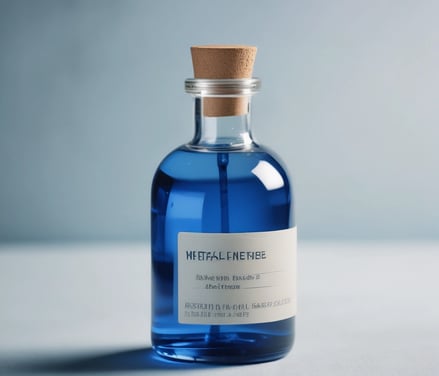Methylene Blue
Feeling Your Pain Relief with Methylene Blue: (MB) is a synthetic dye with a variety of uses in medicine, biology, and research. It has several potentially amazing health benefits to include; Antimicrobial, Antioxidant, Cognitive Health and Pain Relief; both in clinical applications and experimental settings.
HEALING & PAIN RELIEF
12/22/20242 min read


1. Antimicrobial Properties
Methylene blue has demonstrated antimicrobial activity against bacteria, fungi, and parasites. It has been used as a treatment for conditions like malaria and urinary tract infections in some regions.
It also has an antiseptic effect, which is why it has been historically used to treat infections in wounds and skin conditions.
2. Cognitive and Neurological Health
Some studies suggest that methylene blue may have neuroprotective effects and can improve cognitive function, particularly in conditions such as Alzheimer's disease and other forms of dementia. This is likely due to its ability to enhance mitochondrial function and reduce oxidative stress in brain cells.
Methylene blue has been shown to increase the activity of mitochondria, which are the energy-producing components of cells, potentially improving brain energy metabolism and helping protect against neurodegeneration.
3. Antioxidant Activity
As an antioxidant, methylene blue has the ability to neutralize free radicals and reduce oxidative stress. This could potentially play a role in protecting cells from damage and supporting overall health, particularly in chronic diseases linked to oxidative damage.
4. Treatment of Methemoglobinemia
Methylene blue is a well-established treatment for methemoglobinemia, a condition in which hemoglobin is oxidized and cannot carry oxygen effectively. It helps restore normal hemoglobin function by reducing the oxidized hemoglobin back to its functional form.
5. Antidepressant and Mood-Enhancing Effects
Some preliminary research has suggested that methylene blue may have mood-boosting properties and could potentially be used as an adjunctive treatment for depression. It might have effects on serotonin metabolism, which is involved in mood regulation.
6. Cellular and Tissue Staining in Research
Methylene blue is widely used in laboratory settings to stain cells and tissues for microscopy. It helps in visualizing cellular structures, such as the nucleus, and is used in studies involving microbiology and histology.
7. Potential Benefits in Pain Management
Some studies suggest that methylene blue may have pain-relieving properties, although this is still an area of active research. It is believed to work by inhibiting certain pathways involved in pain signaling.
8. Possible Role in Cancer Research
Methylene blue has been explored in cancer research, particularly in the context of photodynamic therapy. When activated by light, methylene blue can generate reactive oxygen species that may damage cancer cells, providing a potential approach for cancer treatment.
9. Detoxification and Liver Health
Methylene blue has also been studied for its potential to support liver health and aid in detoxification processes. Some evidence suggests it may assist in the detoxification of harmful substances by enhancing liver function.
Precautions and Side Effects:
Despite its potential benefits, methylene blue can cause side effects, especially at higher doses. Common side effects include:
Nausea
Vomiting
Headache
Skin discoloration (turns blue)
It can also interact with certain medications, especially antidepressants (due to its effect on serotonin), and should be used with caution in people with certain conditions like G6PD deficiency.
It's important to consult with a healthcare professional before using methylene blue for any medical purpose.
